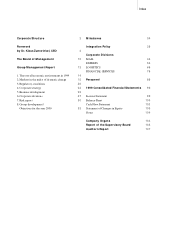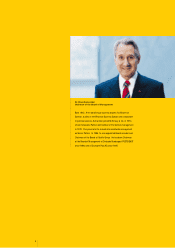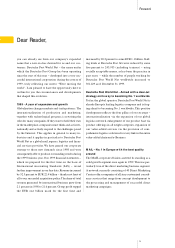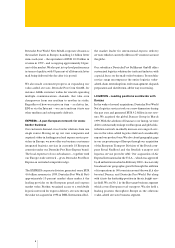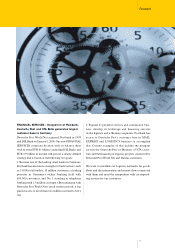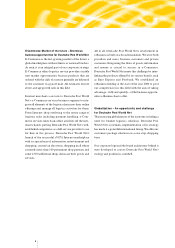DHL 1999 Annual Report Download - page 15
Download and view the complete annual report
Please find page 15 of the 1999 DHL annual report below. You can navigate through the pages in the report by either clicking on the pages listed below, or by using the keyword search tool below to find specific information within the annual report.
14
Overview
The acquisitions of Danzas, Nedlloyd ETD,ASG and
Postbank expanded the range of global logistics serv-
ices and financial services we are able to offer our cus-
tomers. Numerous other acquisitions – which included
foreign express and letter mail service providers – laid
the foundation for the internationalization of these
business segments.
This realignment led to a substantial increase and shift
in revenue. At the same time, our traditional business
segments were also able to achieve significant revenue
growth – by considerable amounts in some cases.As a
result,our profit after tax this year grew to EUR 1.1 bil-
lion,an increase of 20.8 percent over 1998.
Our systematic expansion of new growth segments is
founded on our rigorous and successful restructuring of
all the traditional corporate divisions which existed
when Germany’s “new post office” first began operation
in 1995.
Together, these two components comprise the basis for
our business success and provide the ideal conditions
for a future-oriented, increasingly global Deutsche Post
World Net Group.
1. The overall economic environment in 1999
Deutsche Post World Net was able to raise its sales and
revenue levels last year despite a lack of momentum in
Germany's economy. Compared to the previous year,
Germany's gross domestic product grew by only 1.5
percent in real terms in 1999,noticeably less than the 2.2
percent growth posted in 1998.
The business service, financing and leasing industries
reported the fastest growth last year with a 3.6-percent
real increase. This development was favorable for Deut-
sche Post World Net because these sectors are signifi-
cant users of postal services.By contrast, private consu-
mer spending generated little impetus.At 2.1 percent,
growth in consumer spending was subdued once again
last year, and even undercut the 2.3 percent growth
reported in 1998.Visible trade – an important factor in
generating cross-border mail to and from Germany –
grew at lower levels than in 1998. Due to the long-term
effects of the economic crises in East Asia and other
emerging markets, Germany’s export trade grew by 4.2
percent in 1999, compared to 7.0 percent in 1998.At 7.1
percent, import trade also recorded lower growth in
1999 than in the previous year when the sector posted
an 8.5-percent growth rate.
In the face of these developments, our Group’s interna-
tionalization strategy is of increasing importance.
Growth has been stronger in other economically impor-
tant countries in the EU than in Germany. Further,
cross-border trade is growing at a considerably faster
pace than domestic economic output.Global trade grew
at nearly twice the rate that global production did in the
1990s. As globalization progresses, the division of
specialization between countries will increase and, with
it,the magnitude of global trade.
Internet trade – also widely known as e-Commerce – is a
primary driving force behind these trends.According to
a study by the International Gardner Group, Internet-
related business in Europe reached a magnitude of
some EUR 15 billion in 1999. This study also indicates
that the volume of e-Commerce conducted in Europe
will grow to at least EUR 180 billion by the year 2002.
The e-Commerce field is opening up enormous oppor-
tunities, in particular for Deutsche Post’s cross-border
distribution and logistics networks.
Management Report 1999
Figures in EUR mill.
Revenue
Net profit
1999 1998
22,363 14,669
1,117 925


